ROD 042210
ROD
Thursday, 22Apr10
Tabata Boxing
A timed 2 min of WORK at each station. The last 30 seconds of each station everyone will do a abs exercisies called out by the trainer such as V’s, Planks, Bicycles, Leg raises, Crunches ……
No rest between stations. …NO REST…. We want 100% maximium effort
- Box jumps
- B-A-G
- 1/2 Burpees
- Wall Ball
- B-A-G
- Hit Mitt
- KB High-Pull
- B-A-G
- DB Thrusters
- Med Ball rotations
_____________________________________________________
The greatest revolution of our generation is the discovery that human beings, by changing the inner attitudes of their minds, can change the outer aspects of their lives. – William James
_____________________________________________________
Hamstrung
Probably the most common condition that hinders athletic performance is tight hamstrings. Short tight hamstrings impede athletic performance in one simple but important way: they restrict the closing of the hip joint, i.e. they limit the anterior tilt of the pelvis. This restriction on the movement of the pelvis results in the muscles of the lower back taking up the slack. The negative impact is twofold: 1) the range of motion of the hips is restricted which reduces the power that can be produced by the hips; and 2) the lower back is put into flexion and thus susceptible to injury.
The hamstrings are an extremely important muscle (The hamstrings are actually a group of three muscles: the Biceps Femoris, Semimembranosus and the Semitendinosus) for athletes. The common misconception is that the hamstrings’ main purpose is knee flexion. However, the real job of the hamstrings is opening the hips…strongly and explosively. The hamstrings connect to the pelvis at the Ischial Tuberosities and control the movement of the hip joint, i.e. where the femur meets the pelvis.
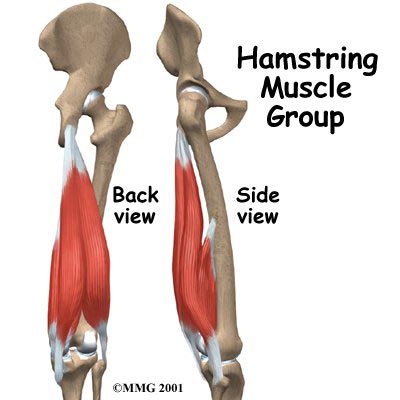
The restriction of pelvic movement often results in a condition defined as “Muted Hip Function”. This will show up in lots of athletic movements and Crossfit exercises: The push press, the squat, the deadlift and their more explosive variations.
Here is a little test to illustrate my point. Grab two jumpstretch bands: a thin one and a thick one. Tie the two bands together and tie one of them to a fixed object like your squat cage. Now try to stretch the thick band. You will notice that the thick band is almost impossible to stretch. The thin band is the one that does most of the stretching. These bands are like your muscles. The thick band represents your hamstrings and the thin band represents your lower back. Most of the time when people stretch, they try to stretch their hamstrings but all they really do is stretch their lower backs. The tighter your hamstrings the more your lower back will do the majority of the stretching.
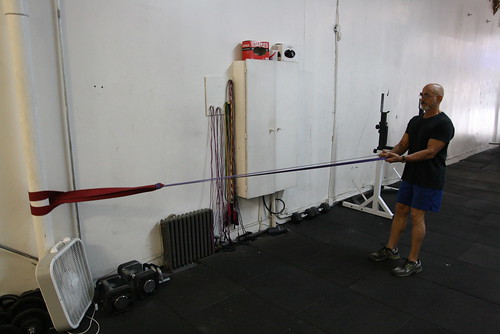
Most people try to stretch their hamstrings by doing toe touches but if you look closely you will see that there is a lot of lower back stretching going on in the typical toe touch stretch. If you keep doing your stretches this way you will train your body to always stretch your lower back when you are trying to stretch your hamstrings. We want to avoid training our body with (and thereby reinforcing) bad movement patterns.
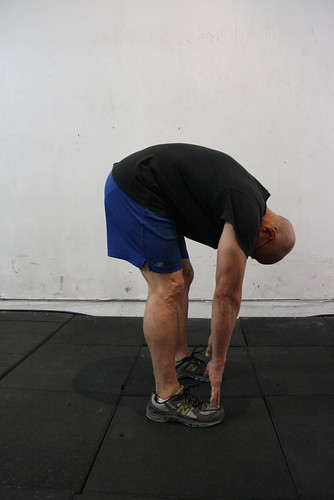
So if one wants to really stretch their hamstrings without stretching their lower backs, then they have to figure out a way to keep the lower back from taking up the slack.
I offer the following solution to the hamstring problem. This stretch, done correctly, immobilizes the hips and spine and allows the athlete to isolate the stretch into the hamstring muscles.
You will need the following props: a strap and an Abmat. You can also use a belt, jump rope or jumpstretch band in place of a strap and can use a towel or rolled up yoga mat in place of the Abmat.
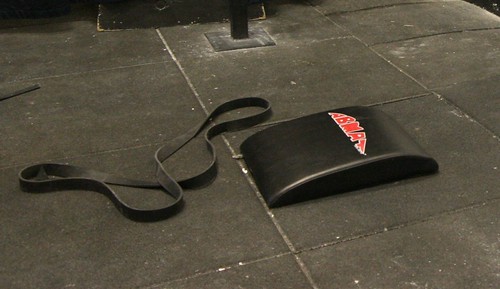
Lie on your back and place the Abmat or rolled up towel or rolled up yoga mat under your lower back. You want to support the natural lordotic arch. By keeping your butt and shoulders on the floor and your lower back supported, you will limit the stretch into the lower back and limit the movement of the pelvis due to the pull of the hamstring.
Take the strap across the sole of your foot and lift your leg as far as you can without lifting your butt off the ground. The non-stretching leg should remain straight and the toes should stay pointed straight up. Press the sole of that foot into a wall. This will help keep the leg engaged and help keep your pelvis grounded and even.

Do not pull too hard with the arms. Try to remain relaxed and let your shoulders come back towards the floor and the weight of your arms passively pull the strap. Rest your head on the floor or on another Abmat.
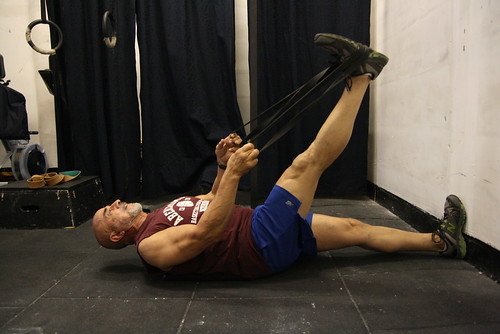
Do not be discouraged by how high you lift your leg. This is a difficult stretch and it will reveal the true length of your hamstring. Try not to cheat by lifting your butt. Keep your butt glued to the floor and work on slowly lifting the leg.
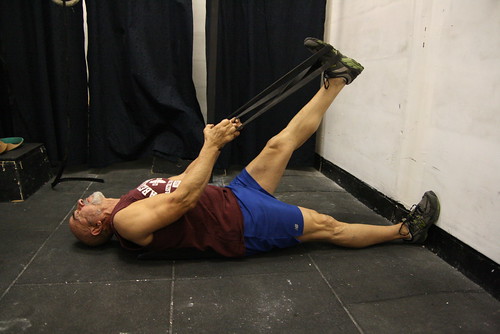
Try to notice where exactly you feel the stretching sensation. You should feel the sensation in the belly of the muscle at the midway point between your butt and the back of your knee. Be careful! If you feel sore in the area behind the knee or the buttocks then you might be overstretching the tendons and not the muscle fibers. Try bending the leg slightly at the knee but still keep pushing up through the heel of the foot.
Try to do this stretch daily after your workout while the body is still warm. Do each leg for at least a minute or longer. Breathe slowly and deeply and try to visualize the hamstrings slowly relaxing and releasing.
Was this helpful? Please post your thoughts and hamstring questions to the comments.
Thank you to Allison and Jacinto from The Black Box for modeling.
